Related Research Articles
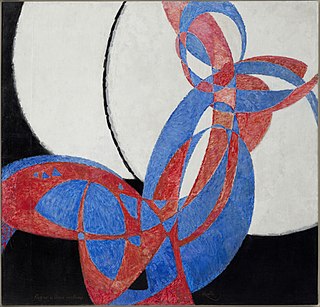
Geometric abstraction is a form of abstract art based on the use of geometric forms sometimes, though not always, placed in non-illusionistic space and combined into non-objective (non-representational) compositions. Although the genre was popularized by avant-garde artists in the early twentieth century, similar motifs have been used in art since ancient times.

Biomorphism models artistic design elements on naturally occurring patterns or shapes reminiscent of nature and living organisms. Taken to its extreme it attempts to force naturally occurring shapes onto functional devices.

Sam Gilliam was an American abstract painter, sculptor, and arts educator. Born in Mississippi, and raised in Kentucky, Gilliam spent his entire adult life in Washington, D.C., eventually being described as the "dean" of the city's arts community. Originally associated with the Washington Color School, a group of Washington-area artists that developed a form of abstract art from color field painting in the 1950s and 1960s, Gilliam moved beyond the group's core aesthetics of flat fields of color in the mid-60s by introducing both process and sculptural elements to his paintings.

Alma Woodsey Thomas was an African-American artist and teacher who lived and worked in Washington, D.C., and is now recognized as a major American painter of the 20th century. Thomas is best known for the "exuberant", colorful, abstract paintings that she created after her retirement from a 35-year career teaching art at Washington's Shaw Junior High School.

Anthony Peter Smith was an American sculptor, visual artist, architectural designer, and a noted theorist on art. He is often cited as a pioneering figure in American Minimalist sculpture.
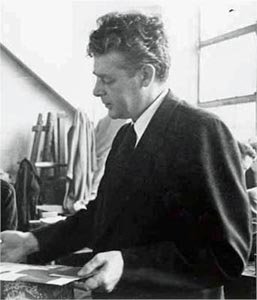
Burgoyne A. Diller was an American abstract painter. Many of his best-known works are characterized by orthogonal geometric forms that reflect his strong interest in the De Stijl movement and the work of Piet Mondrian in particular. Overall, his Geometric abstraction and non-objective style also owe much to his study with Hans Hofmann at the Art Students League of New York. He was a founding member of the American Abstract Artists. Diller's abstract work has sometimes been termed "constructivist". He also did figurative and representational works early in his career working as a muralist for the New York City Federal Arts Project.
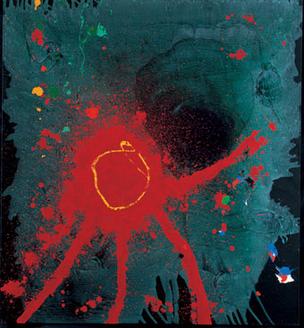
Lyrical abstraction is either of two related but distinct trends in Post-war Modernist painting:

Peter Halley is an American artist and a central figure in the Neo-Conceptualist movement of the 1980s. Known for his Day-Glo geometric paintings, Halley is also a writer, the former publisher of index Magazine, and a teacher; he served as director of graduate studies in painting and printmaking at the Yale University School of Art from 2002 to 2011. Halley lives and works in New York City.
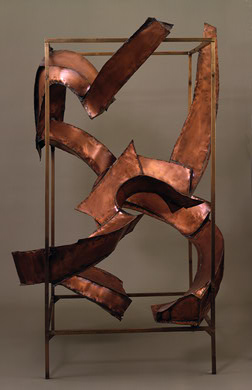
Herbert Ferber was an American Abstract Expressionist, sculptor and painter, and a "driving force of the New York School."
Fran Bull is an American sculptor, painter, and print-maker living and working in Brandon, Vermont and Barcelona, Spain.
George Earl Ortman was an American painter, printmaker, constructionist and sculptor. His work has been referred to as Neo-Dada, pop art, minimalism and hard-edge painting. His constructions, built with a variety of materials and objects, deal with the exploration off visual language derived from geometry—geometry as symbol and sign.
Sinai is a public artwork by the Japanese American artist Isamu Noguchi, located at the Lynden Sculpture Garden, which is near Milwaukee, Wisconsin, United States. Sinai is a cast-iron sculpture measuring 36 inches (910 mm) high, 21 inches (530 mm) wide, and 11 inches (280 mm) deep. It is part of a series of work created between the 1967 and 1969, during which time Noguchi was collaborating with the Japanese stone carver Masatoshi Izumi.

Paul Kelpe was a German-born American abstract painter. His constructions integrating found objects into paintings were the first such works created in the United States and he painted two of the five Williamsburg murals, the first abstract murals in the United States. In addition to his mural work for various American government projects, he was an innovative independent painter and university art professor. He was a pioneer of American abstract art, including his work in Chicago during a period in which abstracts were not well accepted or appreciated.
Albert Swinden (1901–1961) was an English-born American abstract painter. He was one of the founders of the American Abstract Artists, and he created significant murals as part of the Federal Art Project.

Sharon Gold is an American artist and associate professor of painting at Syracuse University. Gold's artwork has been installed at MoMA PS1, Dia Art Foundation, Carnegie Mellon University, Rose Art Museum at Brandeis University, Everson Museum of Art, and Princeton University Art Museum. She was a fellow at MacDowell Colony. Gold's work has been reviewed by Arthur Danto, Donald Kuspit, Ken Johnson, and Stephen Westfall in a variety of publications from Artforum to the New York Times, New York Magazine, Arts Magazine, Art News, and many others. She also taught at Princeton University, Pratt Institute, Virginia Commonwealth University, University of Texas at San Antonio, San Francisco Art Institute, and the Tyler School of Art. Gold received a National Endowment for the Arts fellowship and wrote for Re-View Magazine, M/E/A/N/I/N/G/S, and Artforum. Her artwork spans across minimalism, monochromatic abstraction, geometric abstraction, and representational painting and is conceptually informed by structuralism, existential formalism, and feminist theory.
Amy Ellingson is an American contemporary abstract painter. She is a native of the San Francisco Bay Area and currently lives and works in Santa Fe, New Mexico.
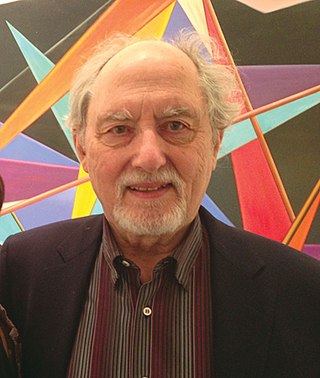
William Conger is a Chicago-based, American painter and educator, known for a dynamic, subjective style of abstraction descended from Kandinsky, which consciously employs illogical, illusionistic space and light and ambiguous forms that evoke metaphorical associations. He is a member of the "Allusive Abstractionists," an informal group of Chicago painters self-named in 1981, whose paradoxical styles countered the reductive minimalism that dominated post-1960s art. In 1982, critic Mary Mathews Gedo hailed them as "prescient prophets of the new style of abstraction" that flowered in the 1980s. In his essay for Conger's fifty-year career retrospective, Donald Kuspit called Conger art-historically daring for forging a path of subjective abstraction after minimalism had allegedly purged painting of an inner life. Despite being abstract, his work has a strong connection to Chicago's urban, lakeside geography and displays idiosyncratic variations of tendencies identified with Chicago Imagist art. A hallmark of Conger's career has been his enduring capacity for improvisation and discovery within self-prescribed stylistic limits.
James Frances Hilleary was a working architect and painter who gained prominence as a member of the Washington Color School movement.

Frank Piatek is an American artist, known for abstract, illusionistic paintings of tubular forms and three-dimensional works exploring spirituality, cultural memory and the creative process. Piatek emerged in the mid-1960s, among a group of Chicago artists exploring various types of organic abstraction that shared qualities with the Chicago Imagists; his work, however relies more on suggestion than expressionistic representation. In Art in Chicago 1945-1995, the Museum of Contemporary Art, Chicago (MCA) described Piatek as playing “a crucial role in the development and refinement of abstract painting in Chicago" with carefully rendered, biomorphic compositions that illustrate the dialectical relationship between Chicago's idiosyncratic abstract and figurative styles. Piatek's work has been exhibited at institutions including the Whitney Museum, Art Institute of Chicago, MCA Chicago, National Museum, Szczecin in Poland, and Terra Museum of American Art; it belongs to the public art collections of the Art Institute of Chicago and MCA Chicago, among others. Curator Lynne Warren describes Piatek as "the quintessential Chicago artist—a highly individualistic, introspective outsider" who has developed a "unique and deeply felt world view from an artistically isolated vantage point." Piatek lives and works in Chicago with his wife, painter and SAIC professor Judith Geichman, and has taught at the School of the Art Institute of Chicago since 1974.

Andrew Spence is an American artist known for abstract paintings that combine a minimalist vocabulary with playful references to the observed world. In the 1970s and 1980s, he gained recognition as one of a number of younger artists who were re-examining geometric modernism through a contemporary lens that invited humor and reference to everyday objects and life experience into the tradition. Spence's method of distilling visual phenomena into simple, emblematic images has been compared to Ellsworth Kelly, but his work has differed in its more even balance between abstraction and recognition, intuitive approach, and varied, expressive paint surfaces. Art in America critic Ken Johnson wrote that his work maintains "an ironic tension between lofty purism of modernist geometry and earth-bound ordinariness of the vernacular sources." In later paintings, Spence has increasingly obscured the original inspirations of his abstractions, in both form and titling. His work belongs to the permanent collections of the Metropolitan Museum of Art, Museum of Modern Art, and Whitney Museum of American Art, among others. He has received a Guggenheim Fellowship and awards from the American Academy of Arts and Letters and National Endowment for the Arts.
References
- ↑ Johnson, Ken. "ART IN REVIEW; 'Biomorphic Abstraction'". The New York Times . Retrieved 11 July 2018.
- 1 2 Donald Kuspit, 2011, “Acrobatic/Erotic Abstraction: Paul Henry Ramirez’s Playconics,” in Playconics, exhibition catalog, introductory essay, p. 1.
- ↑ "Blackout, A Centennial Commission," 2010. Curated by Evelyn Carmen Ramos. Newark Museum, Newark, New Jersey, brochure, p. 2.